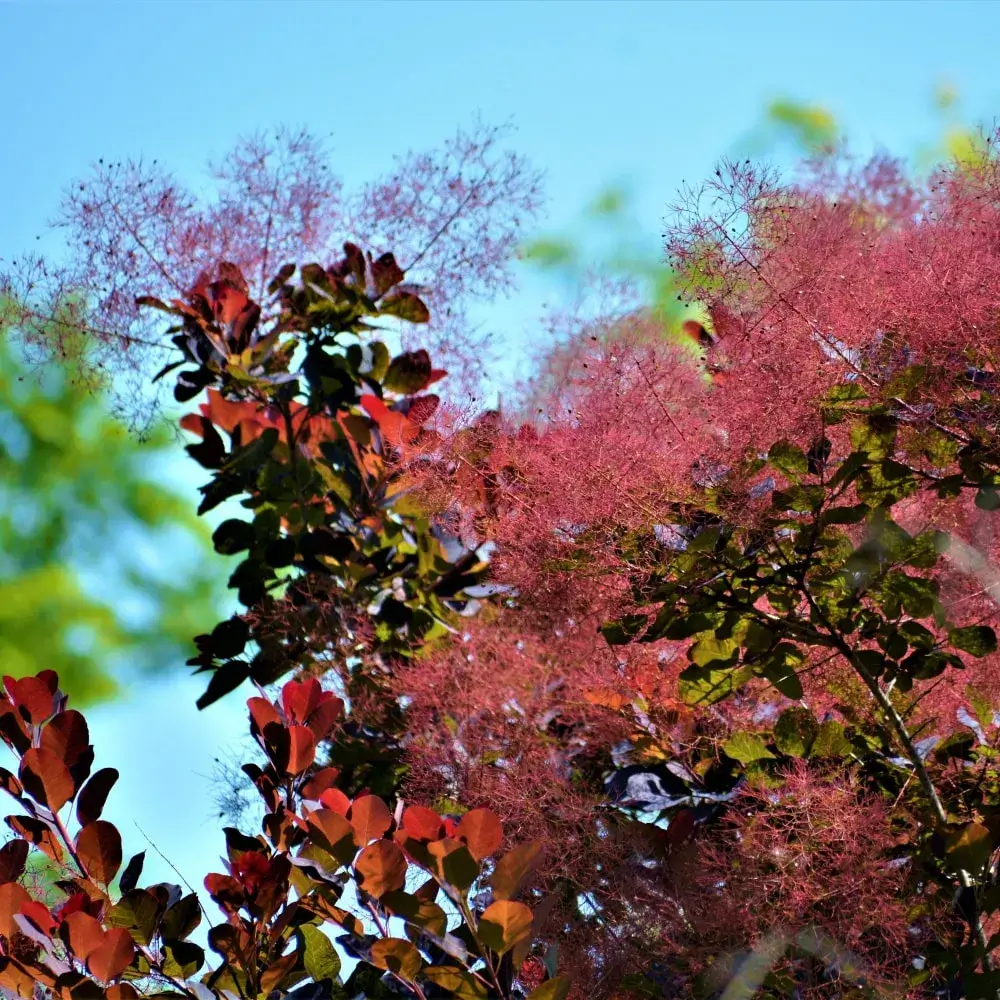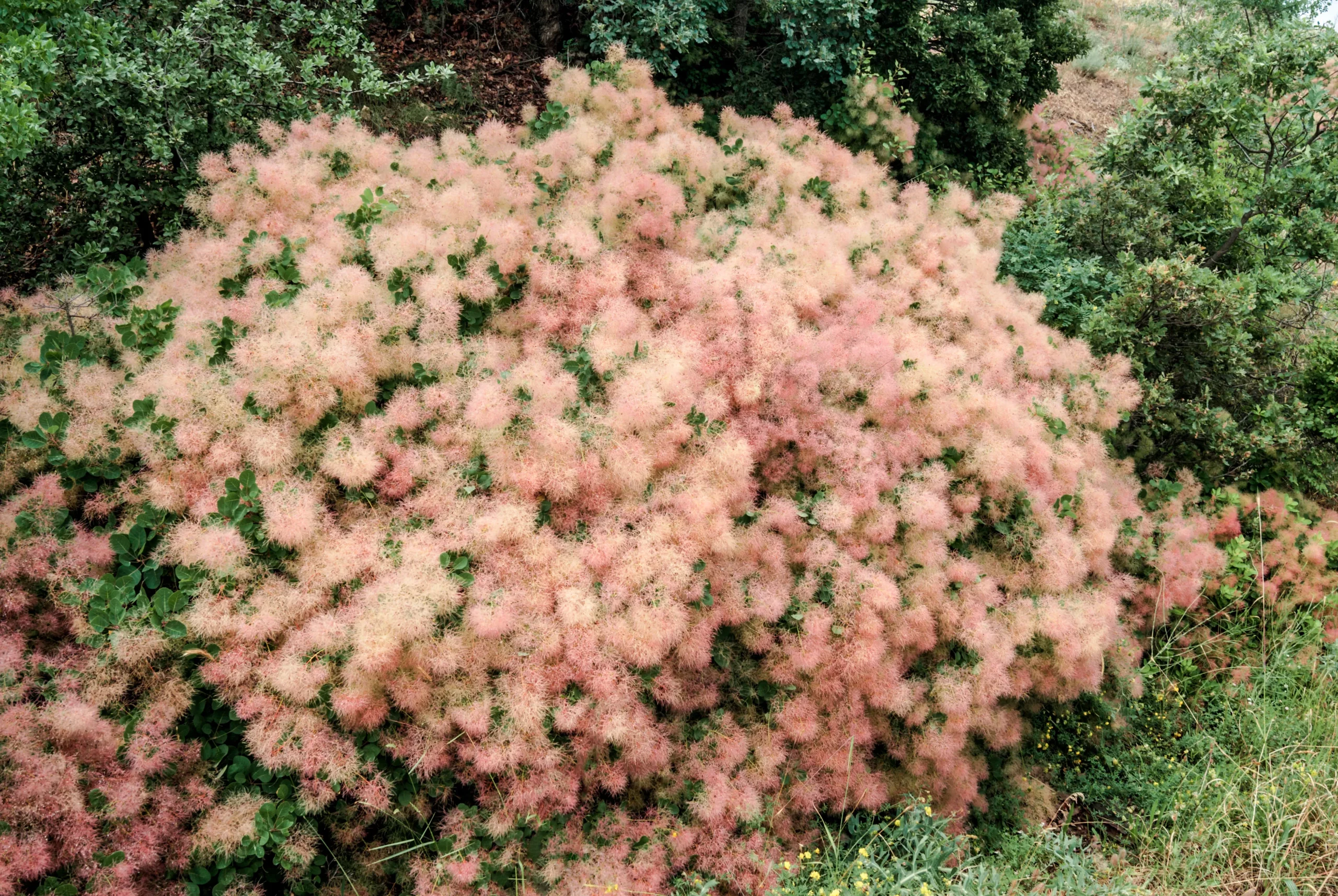Family: Smokebush
Type: Shrub
Other Common Name: Smoketree

The Smoke Tree, known for its distinctive, fluffy flower clusters, is a stunning addition to any landscape. These flower clusters create a smoke-like effect, giving the tree its name. The tree is also admired for its beautiful, round shape and vibrant foliage.
It’s a hardy plant, thriving in zones 4 through 8, and can adapt to various soil types. Smoke Trees are drought-tolerant once established, making them a low-maintenance option for many gardens. Their resilience and adaptability contribute to their popularity.
In autumn, the Smoke Tree’s leaves transform into brilliant shades of red, orange, and yellow. This seasonal change adds a dramatic flair to any garden setting. Throughout the year, the tree provides visual interest, from its spring blooms to its colorful fall foliage.
Hardiness Zone: 4b-5a
Deer Resistant: Yes
Pet Friendly: Yes
Moisture Preference: Dry to moist
Sun Needs: Full sun
Growth Rate: Medium
Average Height (feet): 10
Average Spread (feet): 10
Average Life Span (years): 40
Form: Upright spreading
Flower Color: Yellow
Bloom Season: From early to late summer
Foliage Color: Green
Leaf Fall Color: Orange
Foliage Shape: Round
Bark Color: Brown
Bark Texture: Smooth
Smoke Trees make excellent focal points in a garden due to their unique appearance. Their smoky blooms and vibrant leaves draw the eye, creating a striking visual impact. They are ideal for creating a statement in any yard.
These trees can be used to create natural privacy screens or windbreaks. Their dense foliage and height provide seclusion and protection. Planting them in strategic locations can enhance the privacy and comfort of your outdoor spaces.
Smoke Trees blend well in mixed shrub borders or as part of a larger landscape design. They pair beautifully with both evergreen and deciduous plants. Their unique appearance complements a variety of other plants, adding depth and interest to any garden design.

In a modern garden setting, the Smoke Tree's distinctive look fits perfectly. Its dramatic foliage and unique flower clusters add a contemporary feel. Plant it as a standalone feature or among simple, geometric plantings for a sleek look.
The Smoke Tree is also at home in a rustic country garden. Its natural form and colorful leaves blend seamlessly with a more relaxed, informal style. It pairs well with wildflowers and grasses for a charming, countryside aesthetic.
In a Mediterranean garden, the Smoke Tree's drought tolerance and full sun preference make it a great fit. Its smoky blooms and vibrant foliage complement the warm, earthy tones typical of Mediterranean landscapes.
Use the Smoke Tree as a stunning backdrop for perennial beds. Its distinctive foliage provides a beautiful contrast to flowering perennials. The combination creates a dynamic and colorful garden scene.
Plant Smoke Trees along a driveway or property boundary for a dramatic effect. Their striking appearance marks the entrance to your property and defines the landscape’s edges. This creates a bold and inviting approach to your home.
Incorporate Smoke Trees into rock gardens or xeriscaped areas. Their drought tolerance makes them suitable for these environments. Their unique texture and color add interest to these typically low-maintenance areas.
Select our pre-made garden layouts to create a landscape that’s uniquely yours. Simple, smart, and customizable!
In spring, the Smoke Tree starts to sprout its leaves, setting the stage for the smoky blooms to come. The foliage begins as a deep purple or green, depending on the variety.
Summer is when the Smoke Tree truly shines. Its fluffy, smoke-like blooms are in full display, creating a stunning, cloud-like effect. The foliage remains vibrant, adding to the tree's overall appeal.
The fall brings a dramatic change as the leaves turn to shades of fiery red, orange, and yellow. This colorful display makes the Smoke Tree a standout feature in any autumn landscape.
In winter, the Smoke Tree loses its leaves, revealing an intricate structure of branches. While less colorful, the tree's silhouette against the winter sky is still striking and provides interest in the dormant season.
Choose a sunny location with well-drained soil for your Smoke Tree. It thrives in open spaces where it can receive full sun exposure. Avoid areas that are too shaded or have poor drainage, as this can hinder growth and bloom production.
Full sun is ideal for the Smoke Tree to flourish. It needs at least six hours of direct sunlight daily to produce the best foliage color and blooms. Partial shade is tolerable but may result in less vibrant colors.
Smoke Trees are adaptable to a variety of soil types but prefer well-drained soil. They can tolerate both acidic and alkaline conditions. For optimal growth, plant in soil that is fertile and not too wet.
Give each Smoke Tree plenty of room to grow, spacing them at least 10-15 feet apart. This spacing ensures adequate air circulation and allows each tree to develop its full canopy without competition.
The best time to plant a Smoke Tree is in the spring or early fall. Planting during these cooler times of the year allows the tree to establish its root system before the stress of extreme temperatures.
Dig a hole twice as wide and just as deep as the root ball. Position the tree in the hole, backfill with soil, and water thoroughly. Mulching around the base can help retain moisture and regulate soil temperature.
Water regularly during the first growing season to establish a deep, extensive root system. Once established, Smoke Trees are drought-tolerant and require minimal watering, except in extremely dry conditions.
Fertilize Smoke Trees in early spring with a balanced, slow-release fertilizer. Avoid over-fertilizing, which can lead to excessive leaf growth at the expense of the distinctive blooms.
Prune in late winter or early spring to shape the tree and remove any dead or damaged branches. Smoke Trees respond well to pruning, which can also encourage more dramatic foliage and blooms.
In spring, prune as needed and apply fertilizer. This is also a good time to add mulch and check for any winter damage that needs to be addressed.
During summer, ensure the tree receives enough water, especially in hot, dry periods. Monitor for pests and diseases, treating as necessary to maintain the tree's health.
In the fall, reduce watering as the tree prepares for dormancy. Clean up any fallen leaves and apply a fresh layer of mulch for winter protection.
No specific care is needed during winter. Smoke Trees are dormant during this season, but checking for any damage from severe weather can be beneficial.
A Smoke Tree typically grows to be about 10-15 feet tall and wide. Its size can be managed with regular pruning.
Yes, Smoke Trees can be grown in large containers, but they perform best when planted in the ground. Container-grown trees will need more regular watering and fertilizing.
Smoke Trees are not known to be toxic to pets. However, as with any plant, it’s always best to monitor pets in the garden and prevent them from eating plant material.
Sign up below to get exclusive deals, discounts, and new plant collections—delivered straight to your inbox! Plus, stay inspired with the latest gardening tips, landscaping trends, and DIY garden ideas. Start growing with us today!
A big thank you for subscribing to the PBN Design newsletter.
We're thrilled to have you join our community. Get ready for exciting updates, insightful content, and more delivered straight to your inbox.
Stay tuned!
Go backA big thank you for subscribing to the PBN Design newsletter.
We're thrilled to have you join our community. Get ready for exciting updates, insightful content, and more delivered straight to your inbox.
Stay tuned!
Go back